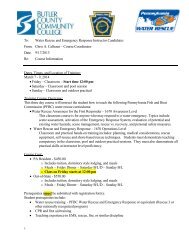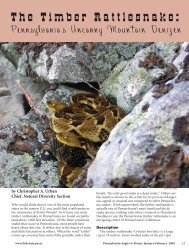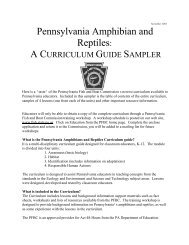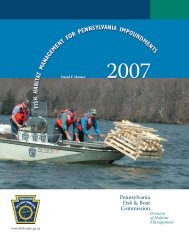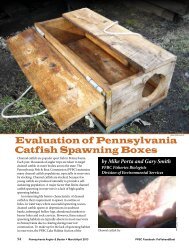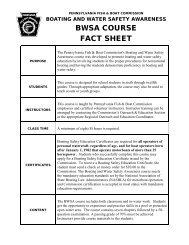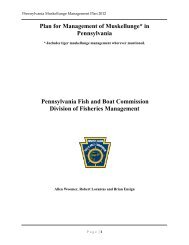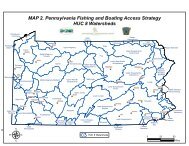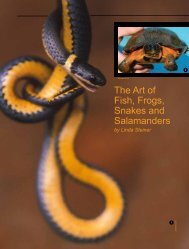Crazy Crayfish
Crazy Crayfish
Crazy Crayfish
Create successful ePaper yourself
Turn your PDF publications into a flip-book with our unique Google optimized e-Paper software.
24<br />
Smart Angler's Notebook<br />
CRAZY<br />
by Walt Dietz<br />
Chela (pincers)<br />
Most anglers know that crayfish make great baits for bass.<br />
They probably also know that crayfish are related to<br />
crabs, shrimp, lobsters and even zooplankton like the<br />
water flea (Order Decopoda). But did you know there are<br />
12 species of crayfish in Pennsylvania? Did you know<br />
that crayfish make great baits for other fish like trout?<br />
There is even a crayfish that has been introduced to our<br />
waters from other states. Let’s take a closer look at<br />
crayfish.<br />
<strong>Crayfish</strong> are easy to recognize with their pincers and<br />
armorlike carapace. Some people also call them<br />
“crawdads” or “crawfish.” They are like the army tanks of<br />
the aquatic world, thanks to five pairs of jointed legs (the<br />
first pair are pincers). They can move over obstacles and<br />
in any direction—forward, sideways or backward. Swimmerets<br />
(small appendages) under the abdomen help<br />
them with swimming and balance. A cluster of purplish<br />
eggs can sometimes be seen attached to a female’s swimmerets.<br />
<strong>Crayfish</strong> can also shoot backward by flexing<br />
their tail fan and contracting their abdominal muscles<br />
in the jointed tail. Break a leg, pincer or swimmeret?<br />
No problem: <strong>Crayfish</strong> can grow new ones!<br />
A hard exoskeleton protects crayfish. <strong>Crayfish</strong><br />
must shed, or molt, as they grow. Those empty<br />
“crayfish shells” you see in the water are really shed<br />
exoskeletons. <strong>Crayfish</strong> are very soft until the<br />
exoskeleton hardens. These “softshells” are vulnerable<br />
to predators.<br />
<strong>Crayfish</strong> have amazing adaptations. They breathe<br />
through gills under the carapace. Their eyes are on<br />
movable stalks to allow sight in different directions.<br />
Antennae sense prey and predators. They emit chemical<br />
cues to identify one another and signal mating. They can<br />
even change color to match their habitat.<br />
Pennsylvania Angler & Boater, September-October 2003<br />
Telson<br />
Eyes<br />
Antennae<br />
Antennule<br />
Rostrum<br />
Uropods<br />
Jointed<br />
legs<br />
Carapace<br />
<strong>Crayfish</strong> are important as predators and prey in the<br />
aquatic food chain. They are omnivores (feed on plants<br />
and animals) and scavengers. They eat snails, insects,<br />
worms, tadpoles, dead aquatic animals, algae and vegetation.<br />
<strong>Crayfish</strong> also make a tasty treat for fish, reptiles and<br />
mammals. When taken from clean water and properly<br />
cooked, crayfish are a great meal for humans.<br />
www.fish.state.pa.us
Rusty crayfish<br />
have large<br />
pincers and often<br />
have two rusty<br />
spots on each<br />
side of the carapace.<br />
The rusty crayfish (Orconectes<br />
rusticus) was introduced from Midwestern<br />
states. It is sold commercially as fish<br />
bait. It is aggressive and competes with<br />
native species for food and space. It will<br />
also overgraze aquatic vegetation.<br />
Help slow the spread of nuisance species. Don’t release<br />
unused bait into the water. Examine or clean equipment<br />
to prevent transfer of plants and animals to other waters.<br />
Some Common Pennsylvania <strong>Crayfish</strong><br />
Eastern crayfish or Appalachian brook crayfish (Cambarus<br />
bartonii)<br />
Common in most of Pennsylvania.<br />
Found in cold mountain streams under rocks or abandoned<br />
burrows.<br />
Northern crayfish (Orconectes virilis)<br />
Found in northwest and southcentral Pennsylvania.<br />
Lives in warm, turbid ponds and slow-moving water with<br />
vegetation and debris.<br />
Northern clearwater crayfish (Orconectes propinquus)<br />
Found in northwest Pennsylvania.<br />
Lives under rocks with muddy or sandy bottoms.<br />
Chimney crayfish or devil crayfish (Cambarus diogenes)<br />
Found in western Pennsylvania.<br />
Prefers low elevations, and burrows near spring-fed swamps or<br />
logged areas along streams.<br />
Allegheny crayfish (Orconectes obscurus)<br />
Found in central and western Pennsylvania.<br />
Lives under rocks with muddy or sandy bottoms.<br />
Monongahela crayfish or blue mountain mudcrawler<br />
(Cambarus monongalensis)<br />
Found in southwestern Pennsylvania.<br />
Burrows in foothills near water, and prefers clear water nearby<br />
or underground springs.<br />
Spinycheek crayfish (Orconectes limosus)<br />
Lives in eastern Pennsylvania.<br />
Prefers small, quiet streams of lowlands, ponds and ditches.<br />
Information about our state’s other crayfish can be found<br />
at the Pennsylvania <strong>Crayfish</strong> Reference Collection link<br />
under the Web Resources section.<br />
Collecting<br />
<strong>Crayfish</strong> are easy to catch. Look for them in any pond,<br />
lake, river or stream. Roll rocks over in shallow water and<br />
grab behind the pincers (thorax), or use a dip net. Or<br />
have one angler hold a minnow seine while another<br />
angler lifts rocks and swooshes crayfish downstream<br />
toward the net.<br />
Storing<br />
<strong>Crayfish</strong> are also easy to store. Use a cooler with wet<br />
grass or aquatic plants instead of a bait bucket with water.<br />
They’ll keep for days if you store them in a cool shady<br />
spot and keep the grass wet. Wrap softshells in wet<br />
newspaper, cheesecloth or cotton material. Store them in<br />
the refrigerator and they will stay soft for a week.<br />
It’s the LAW!<br />
•A fishing license is required of those 16 and older to<br />
collect crayfish and other fishbait or baitfish.<br />
• No closed season or minimum size for crayfish.<br />
Pennsylvania law allows a daily limit of 50 combined<br />
fishbait species.<br />
Fishing Tips<br />
Use live crayfish for bass, trout, perch, carp and catfish.<br />
Softshells are deadly! Hook them through the tail or<br />
break them apart and use the body parts. Rig with a<br />
splitshot, slip or swivel sinker. Or try a jighead. Move<br />
your line occasionally to pull live crayfish from their<br />
rocky hiding spots.<br />
Web Resources<br />
Association of Astacology<br />
www.uku.fi/english/organizations/IAA/<br />
<strong>Crayfish</strong> World<br />
www.crayfishworld.com<br />
<strong>Crayfish</strong> Corner<br />
www.mackers.com/crayfish/<br />
Invasive Species<br />
www.protectyourwaters.net<br />
Pennsylvania <strong>Crayfish</strong><br />
Reference Collection<br />
www.lhup.edu/~tnuttall<br />
pennsylvania_crayfish_reference_.htm<br />
www.fish.state.pa.us Pennsylvania Angler & Boater, September-October 2003 25




